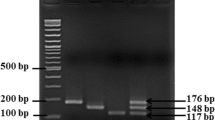Abstract
Various variants of ISO 6888-1:1999 and ISO 6888-3:2003 methods for the detection of Staphylococcus aureus were evaluated and improved for their application to conduct analysis in spices and herbs. Improvement substantiated in washing of the sample to remove compounds interfering with the analysis and in the use of PCR for final detection, instead of plating on Baird-Parker agar, to improve sensitivity at high backgrounds and to save time. The evaluation of the method variants was based on determination of the detection limit (LOD) using series of artificially contaminated spices (allspice, black pepper, cinnamon, nutmeg, paprika, vanilla) and herbs (basil, oregano, parsley, thyme). The method without enrichment, ISO 6888-1:1999, produced LODs of 103–105 CFU/g with no positive effect of washing the sample or use of PCR for final detection. The method with enrichment, ISO 6888-3:2003, had LOD of 100 CFU/g for basil, black pepper, paprika and parsley. If the washing step was added and PCR was used for final detection, LOD of 100 CFU/g was determined also for cinnamon, nutmeg and vanilla, and LOD of 101 CFU/g was determined for allspice. For oregano and thyme, which strongly inhibit the growth of S. aureus, an alternative enrichment-independent method based on direct DNA extraction coupled to real-time PCR may be advantageous.
Similar content being viewed by others
References
Dalmasso M, Bolocan AS, Hernandez M, Kapetanakou AE, Kuchta T, Manios SG, Melero B, Minarovičová J, Muhterem M, Nicolau AI, Rovira J, Skandamis PN, Stessl B, Wagner M (2014) Comparison of polymerase chain reaction methods and plating for analysis of enriched cultures of Listeria monocytogenes when using the ISO11290-1 method. J Microbiol Methods 98:8–14
De Buyser ML, Audinet N, Delbart MO, Maire M, Francoise F (1998) Comparison of selective culture media to enumerate coagulase-positive staphylococci in cheeses made from raw milk. Food Microbiol 15:339–346
Food and Agriculture Organization of the United Nations (FAO) and World Health Organization (WHO) (2014) Ranking of low moisture foods in support of microbiological risk management. Preliminary report of FAO/WHO expert consultation on ranking of low moisture foods. R. o. a. f. w. c. process: 1-254
Garbowska M, Berthold-Pluta A, Stasiak-Rózańska L (2015) Microbiological quality of selected spices and herbs including the presence of Cronobacter spp. Food Microbiol 49:1–5
International Organization for Standardization (1999a) ISO 6888-1:1999. Microbiology of food and animal feeding stuffs – Horizontal method for the enumeration of (1999a) ISO coagulase-positive staphylococci (Staphylococcus aureus and other species): part 1: technique using Baird-Parker agar (1999a) ISO medium. Geneva
International Organization for Standardization (1999b) ISO 6888-2:1999. Microbiology of food and animal feeding stuffs – horizontal method for the enumeration of coagulase-positive staphylococci (Staphylococcus aureus and other species): part 2: technique using rabbit plasma fibrinogen medium. Geneva
International Organization for Standardization (2003) ISO 6888-3:2003. Microbiology of food and animal feeding stuffs – horizontal method for the enumeration of coagulase-positive staphylococci (Staphylococcus aureus and other species): part 3: detection and MPN technique for low numbers. Geneva
Le Loir Y, Baron F, Gautier M (2003) Staphylococcus aureus and food poisoning. Genet Mol Res 2:63–76
Sagoo SK, Little CL, Greenwood M, Mithani V, Grant KA, McLauchlin J, de Pinna E, Threlfall EJ (2009) Assessment of the microbiological safety of dried spices and herbs from production and retail premises in the United Kingdom. Food Microbiol 26:39–43
Schelin J, Wallin-Carlquist N, Cohn MT, Lindqvist R, Barker GC, Radstrom P (2011) The formation of Staphylococcus aureus enterotoxin in food environments and advances in risk assessment. Virulence 2:580–592
Schoeller NP, Ingham SC (2001) Comparison of the Baird-Parker agar and 3MTM PetrifilmTM rapid S. aureus count plate methods for (1999a) ISO detection and enumeration of Staphylococcus aureus. Food Microbiol 18:581–587
Sospedra I, Soriano JM, Manes J (2010) Assessment of the (1999a) ISO microbiological safety of dried spices and herbs commercialized in Spain. Plant Foods Hum Nutr 65:364–368
Trnčíková T, Hrušková V, Oravcová K, Pangallo D, Kaclíková E (2009) Rapid and sensitive detection of Staphylococcus aureus in food using selective enrichment and real-time PCR targeting a new gene marker. Food Anal Methods 2:241–250
Van Doren JM, Neil KP, Parish M, Gieraltowski L, Gould LH, Gombas KL (2013) Foodborne illness outbreaks from microbial (1999a) ISO contaminants in spices, 1973-2010. Food Microbiol 36:456–464
Vicosa GN, Moraes PM, Yamazi AK, Nero LA (2010) Enumeration of coagulase and thermonuclease-positive Staphylococcus spp. in raw milk and fresh soft cheese: an evaluation of Baird-Parker agar, rabbit plasma fibrinogen agar and the petrifilm staph express count system. Food Microbiol 27:447–452
Vitullo M, Ripabelli G, Fanelli I, Tamburro M, Delfine S, Sammarco ML (2011) Microbiological and toxicological quality of dried herbs. Lett Appl Microbiol 52:573–580
Witkowska AM, Hickey DK, Alonso-Gomez M, Wilkinson GM (2011) The microbiological quality of commercial herb and spice (1999a) ISO preparations used in the formulation of a chicken supreme ready meal and microbial survival following a simulated industrial heating process. Food Control 22:616–625
Acknowledgments
This research was carried out in frames of the FP7-SEC-2012-1 project “Securing the spices and herbs commodity chains against deliberate, accidental or natural biological and chemical contamination (SPICED, No. 312631)”. The authors thank to Dr. V. Janská and Dr. K. Ženišová for valuable advice on methodology.
Author information
Authors and Affiliations
Corresponding author
Ethics declarations
Conflict of Interest
Tereza Cabicarová declares that she has no conflict of interest. Eva Kaclíková declares that she has no conflict of interest. Anneluise Mader declares that she has no conflict of interest. Jana Minarovičová declares that she has no conflict of interest. Janka Koreňová declares that she has no conflict of interest. Tomáš Kuchta declares that he has no conflict of interest.
Human and Animal Rights
This article does not contain any studies with human or animal subjects.
Informed Consent
Informed consent is not applicable in this study.
Rights and permissions
About this article
Cite this article
Cabicarová, T., Kaclíková, E., Mader, A. et al. Improvement of the Detection Sensitivity for Staphylococcus aureus in Spices and Herbs. Food Anal. Methods 9, 1980–1984 (2016). https://doi.org/10.1007/s12161-015-0379-0
Received:
Accepted:
Published:
Issue Date:
DOI: https://doi.org/10.1007/s12161-015-0379-0




